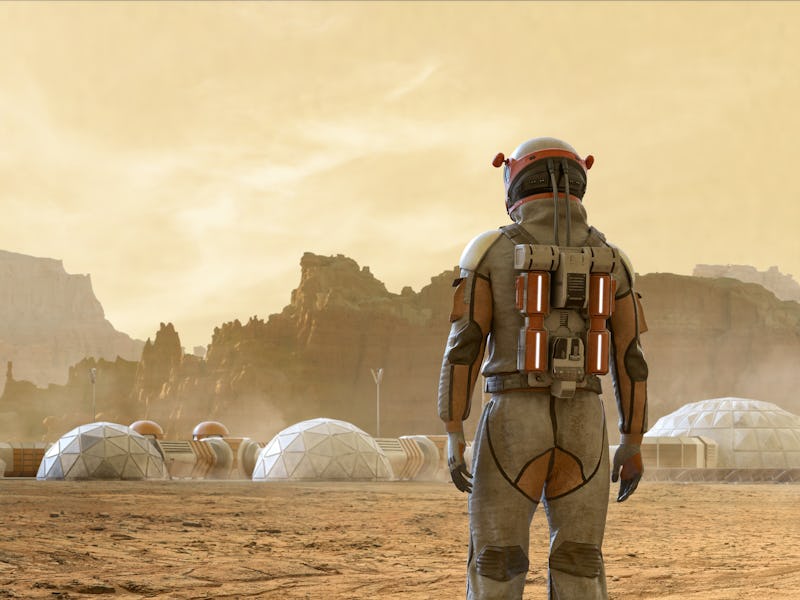Astronomers have a new theory that defies a fundamental necessity of life
So-called land planets may be habitable. Here’s why that matters.

When searching for life on another planet, we often look to Earth-like worlds that have what it takes to sustain living organisms. But some scientists are now arguing that may not always be the best place to look.
A recent paper suggests that so-called “land planets” that have very little water may be better suited for habitability than Earth-like water worlds.
The habitable zone — When searching for habitability beyond Earth, scientists look for planets that orbit within their star’s habitable zone.
The habitable zone (also known as the Goldilocks zone) is the area around a star where the temperatures would be not too cold nor too hot for liquid water to exist on an orbiting planet. That’s important because water is considered one of the main building blocks of life. Life on Earth started in the water, and around 71 percent of Earth’s surface is covered in water, making Earth a water world.
Earth is (thankfully) in the Goldilocks zone, just the right distance away from the Sun to have bodies of water. If Earth switched positions with Mercury, all of our water would boil up and evaporate. Switching positions with Neptune would freeze all that precious H2O.
So as the hunt for an Earth-like rocky exoplanet continues, those that are within the same distance from their host star are considered to be more likely habitable or able to sustain water.
They may not look like Earth, but dry planets may still be capable of carrying some form of life.
What’s new — In the search for extraterrestrial life, most of the focus is on exoplanets with a large amount of liquid water on their surface. However, this new study focused on land planets — or planets with very little water on their surface.
The idea is based on the climate model of planets, which estimates that while planets that lie outside of their star’s habitable zone can’t sustain enough water, some may be warm enough to have liquid water if there’s enough carbon dioxide in their atmosphere.
The carbon dioxide would lead to the warming of the planet’s atmosphere in what is known as the greenhouse effect, the same effect that is warming our own planet with the rise of industrialization.
The study also suggests that land planets would have a much drier atmosphere compared to a planet with large amounts of water on its surface. This would lead to a wider habitable zone for land planets, according to the study.
In order to test this theory, the scientists behind the study created a model of a rocky, land exoplanet with a dry climate and little water on its surface. The drier climate resulted in less snow and fewer clouds.
They also found that the freezing limit, or the point at which the water on the surface of the planet would turn into ice, decreased with a land planet compared to a water-rich planet. This means the land planet could sustain its water the further away it is from its host star.
WHAT’S NEXT — The scientists behind the recent study are hoping to confirm their model using real-life observations.
With the launch of the James Webb Space Telescope, astronomers are hoping to get a better look at exoplanets and probe their atmosphere. This recent study expands the scope of potentially habitable exoplanets to observe, perhaps finding a planet that is far from being a water world like Earth but still capable of sustaining water, and possibly life.
Abstract: The climates of terrestrial planets with a small amount of water on their surface, called land planets, are significantly different from the climates of planets having a large amount of surface water. Land planets have a higher runaway greenhouse threshold than aqua planets, which extends the inner edge of the habitable zone inward. Land planets also have the advantage of avoiding global freezing due to drier tropics, leading to a lower planetary albedo. In this study, we systematically investigate the complete freezing limit for various surface water distribution using a three-dimensional dynamic atmospheric model. As in a previous study, we found that a land planet climate has dry tropics that result in less snow and fewer clouds. The complete freezing limit decreases from that for aqua planets (92% S0, where S0 is Earth's present insolation) to that for land planets (77% S0) with an increasing dry area. Values for the complete freezing limit for zonally uniform surface water distributions are consistently lower than those for meridionally uniform surface water distribution. This is because the surface water distribution in the tropics in the meridionally uniform cases causes ice-albedo feedback until a planet lapses into the complete freezing state. For a surface water distribution using the topographies of the terrestrial planets, the complete freezing limit has values near those for the meridionally uniform cases. Our results indicate that the water distribution is important for the onset of a global ice-covered state for Earth-like exoplanets.
This article was originally published on